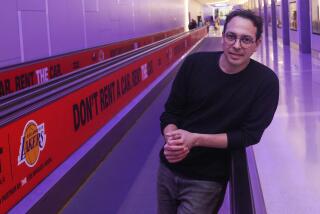Security Is Prime Topic at Airport Architecture Fair
- Share via
ORLANDO, Fla. — Don Mauras sidled up to the U.S. Army’s Homeland Defense table at the Orange County Convention Center and pocketed two complimentary guidebooks on the medical response to biological and chemical casualties.
Mauras is not a doctor, nor even an emergency preparedness buff. He’s an airport architect for the New Orleans Aviation Board.
“I’m going to give it to my safety guy,” Mauras said. “You never talked about biological and chemical stuff. Maybe some of it is overreaction, but some of it’s warranted.”
Welcome to the new world of airport design conventions, post-Sept. 11, where dry recitations of average annual enplanements have given way to frank talk of bioterrorism and fuel-air bombs.
Passenger Terminal Expo 2001, in its sixth edition, is the ultimate airport insider’s venue. It’s a place where bureaucrats mingle with engineers and architects, and shop everything from baggage handling systems to acoustic tile and the latest fashions in trash receptacles.
But this year, attendees got a dose of biological warfare mixed with talks on blast-protecting buildings and verbal attacks on airline lobbyists and slow-moving politicians.
“These are apocalyptic times,” said moderator Peter Wilkins, a security consultant and former director of safety and security for the British Airport Authority, before a somber crowd of about 200 in the Orange County Convention Center on Monday. “These are not times for minor tunings to the system. It’s the time, ladies and gentlemen, for thinking the unthinkable.”
The early lessons hinted at here offer a timely primer for airports such as Los Angeles International, where expansion and renovation projects have come to a halt and are being reevaluated with passenger security paramount to niceties.
After the Sept. 11 terrorist attacks on the World Trade Center and the Pentagon, experts say the fundamentals of airports will have to change to meet new security needs--from making room for more sophisticated baggage and passenger screening, to simple measures such as shatterproof glass. None of those topics ever dominated a conference like this, according to more than one veteran of these affairs.
And for some, politics will have to change. “We got here in the U.S. because of a seriously flawed political system,” said former FAA security chief Billie Vincent, now a private sector consultant, who blamed airline lobbyists and politicians for delaying important security measures on economic grounds.
Vincent cited $62.85 million in lobbying by airlines from 1997 to 2000, much of which, he said, was in opposition to security measures the industry considered too expensive. “That doesn’t say that it was all against security, but that was the airlines lobbying to get what they wanted,” he said.
Ronald Polillo, the FAA’s manager of security research and development projects, painted a somewhat different picture. He said the agency has been at the forefront in stimulating technological fixes to security but has been stymied by slow rule-making procedures and funding shortfalls.
For instance, Polillo said, the FAA began funding production of high-tech explosive detection devices and got $144 million from Congress in 1997. The next year, it got nothing, and production had to be scaled back.
A regulation requiring longer training for screeners was halted by the Bush administration in its wholesale freeze on all rules enacted by the outgoing Clinton administration, Polillo said.
Out on the convention’s display floor, those frustrations were evident in a chagrined Roddy Boggus, partner in the Dallas-based Hodges Boggus architecture firm, which specializes in designing security screening facilities.
Boggus’ firm took such a financial blow from canceled projects after the Sept. 11 attacks that he cut staff by 25%. He brought what he called the scaled-back Home Depot version of his usual display, which he carted in his own car to save money.
Boggus showed a colorful brochure with the spacious security checkpoints he designed to accommodate the most advanced screening at the Dallas-Fort Worth International Airport. “I can tell you they are not using it the way we designed it,” he said. “We don’t control their equipment and personnel. So, architecturally, the space we gave them for security doesn’t help.”
More to Read
The biggest entertainment stories
Get our big stories about Hollywood, film, television, music, arts, culture and more right in your inbox as soon as they publish.
You may occasionally receive promotional content from the Los Angeles Times.











